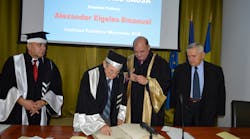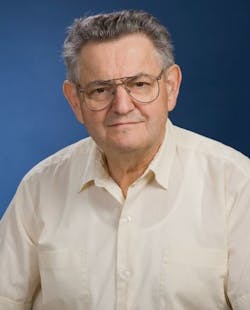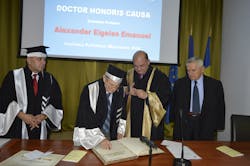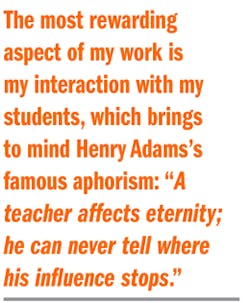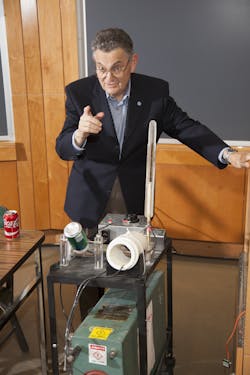Alexander Emanuel is a professor of electrical and computer engineering at Worcester Polytechnic Institute in Massachusetts. In 1984, he founded the Institute of Electrical and Electronics Engineers’ (IEEE) International Conference on Harmonics in Power Systems. In addition to a 45-year-plus career in electric power research and education, he is the author of “Power Definitions and the Physical Mechanism of Power Flow” (Wiley, 2010).
Emanuel was recently awarded an honorary doctorate by the Polytechnic University of Bucharest, the largest technical university in Romania. In the following interview with Electronic Design, he discusses receiving this distinction; his life as a professor, researcher, and engineer; and how he envisions the future of power electronics unfolding.
Congratulations on your honorary doctorate by the Polytechnic University of Bucharest. How does it feel to be honored by the largest technical university in your native Romania?
AE: It was a pleasant and unexpected surprise, followed by many moments of soul-searching. The honorary doctorate honors the recipient and his or her institution. I have no reservation acknowledging that the productive environment provided by my colleagues and my students at WPI was conducive to good research and good publications. Otherwise, I am the same old teacher and engineer; nothing has changed in my routine. I am deeply grateful to my colleagues at the Bucharest Polytechnic University for their confidence in me, and I would like to express my admiration and respect for them.
MG: What is the most exciting thing about your job as a faculty member of Worcester Polytechnic Institute?
AE: The most rewarding aspect of my work is my interaction with my students, which brings to mind Henry Adams’s famous aphorism: “A teacher affects eternity; he can never tell where his influence stops.” My students today are my colleagues of tomorrow. Some will complete my unfinished work; others will make original contributions that will push the envelope of knowledge to higher levels. During my 40-plus years as a teacher I gradually learned that teaching is a special privilege. It is a spiritual experience and an important responsibility.
When I was young I gave research a higher priority than teaching. As I matured this order of priorities has reversed. I had two wonderful mentors here at WPI: Deans John van Alstyne and William Grogan. From them I learned how to listen to my students and how to become their older friend and mentor. I love to teach students how to work, to have good attitudes, to be courageous, to take responsibility for their own ideas, and to think independently. When I retire, I will miss my students greatly.
MG: In Romania, do you find that a certain percentage of college students drop out of engineering programs? If so, is there anything they do to keep them more engaged in the program?
AE: All universities face some student attrition. I think there are two reasons: 1) Some students are not yet mature enough, nor ready for the topics taught. The class level may be over their heads, which can leads to discouragement. 2) Other students face difficulties paying for college. In many countries, higher education is free or just symbolic. In those countries, we see the reverse situation: “eternal students” who love bring students and postpone their graduation by a few years. I once asked a Romanian professor, “How are your students?” He smiled, sighed, and replied, “I am sorry to say so, but my students can be divided in two groups: to one group belong the students who do not love to study; in the second group are students who dream of going to America.” The unhappy condition can be greatly mitigated if the high school level is raised up and if adequate jobs become available. In our country we need more scholarships.
: As an electrical engineer myself, when I was in college, sometimes I was the only woman in a class of 30 students. Do you think more women are now joining engineering programs?
AE: I am glad to tell you that every year more and more young women join our WPI community. Today, they represent more than 30% of the student body. Many are outstanding scholars. In fact, year after year the top student in my power electronics class is a woman.
MG: As the founder of the IEEE International Conference of Harmonics in Power Systems—and since we live in a world where the number of electronic devices using switched-mode power supplies (SMPSs) is increasing at a steady pace—how important for you the standards that limit harmonic current emissions such as IEC61000-3-2, or initiatives such as 80 PLUS?
AE: I am glad you raise the issue of harmonics and their limitation. Nonlinear loads and time-varying loads inject harmonic currents that cause voltage and magnetic field waveform distortions. Many years ago I coined the term “harmonic pollution” to describe the electromagnetic field caused by harmonics. Many manufacturers of inverters and converters did not like the name harmonic or electromagnetic pollution and tried to avoid it, but nevertheless it stuck.
Today we have ample literature, recommendations, and standards that provide limits and guidelines for harmonic pollution limitation. The first recommendation I am aware of was based on a study completed by WPI for New England Electric System in 1996. It recommended a total harmonic distortion of the voltage less than or equal to 4.7%. Later, IEEE and European standards raised the limit to 5.0%.
MG: You continue to work on active filters that help harmonic pollution. What are the new trends in active filters?
AE: I became interested in active filters in 1966. Professor Hirofumi Akagi in his book “Instantaneous Power Theory and Applications” (Wiley 2006) cited my pioneering work, which predicted the use of active filters. Conventional static filters have a major drawback: Due to their inability to continuously adjust non-active power, they also absorb the current harmonics injected by neighboring customers that are using filters. This condition leads to unexpected, unwanted overloading of the filters.
Moreover, the static filters are prone to series and parallel resonances. Active filters can limit and adjust the compensation of unwanted harmonics. The early active filters were very expensive and voluminous—more of a laboratory curiosity. Progress in the manufacture of solid-state switches, the wide acceptance of IGBTs, the PWM technique, and the development of smart switches led to today’s filters, which can operate with very low power losses, with sophisticated programmable tasks, and with ability to correct the power factor (PF).
These modern active filters are designed to maintain a balance of phase-to-phase and phase-to-neutral voltage. More sophisticated units are flexible and make it possible to select the harmonics that should be blocked or compensated. The cost, while still high, is compensated by the advantages offered by a reliable and clean electric energy.
What other technologies are of interest to you?
AE: In recent years I have studied the possibility of using distributed generators (eolean and photovoltaic systems) not only as suppliers of active and reactive powers, but also as active filters. A good part of my research time is dedicated to the study of energy storage devices meant to maintain the stability of alternating machines. My main interest, however, is the definitions and measurement of powers. This is a very old query that has not yet been solved to the satisfaction of practicing engineers. I lead the IEEE working group that oversees the IEEE standard 1459-2010. These days we are stuck at the definition of the effective voltage in three-phase, four-wire systems with unbalance and non-sinusoidal loads. It is a “jungle,” but we are going to “cross the water.”
MG: Yole Développement estimates that the gallium-nitride (GaN) device market size will reach $303 million by 2020. Thinking about emerging/evolving technologies such as envelope tracking, how do you envision the world of power electronics in the future?
AE: Power electronics technology has a most interesting history. The early engineers started with the mercury rectifiers, and then moved on to the thyratron and magnetic amplifiers, then to the copper-oxide rectifier, followed by four layers solid-state switches and power transistors. Dedicated engineers were diligently working to get closer to the ideal solid-state switch; such a switch will have negligible power losses—hence the ability to conduct high currents. It will withstand (block) very high voltage and will easily transfer the heat converted from its losses.
Moreover, such an ideal switch will turn on and off in no time. Silicon, and to a limited degree germanium, were the choice material for decades. Then came silicon-carbide, a wonderful material that led to emerging technologies based on SiC MOSFETs and SiC IGBT with ratings as high as 1.0 to 30 kV. Engineers talk about the fourth generation of SiC MOSFETs able to perform with junction temperatures of 150°C. Such devices provide more compact packaging and help to build converters and inverters with higher efficiencies, able to operate in the MHz frequency range.
However, as in the past, the research and development effort to build a better mousetrap was rewarded with a better solid-state material, gallium-nitride. This semiconductor is even closer to the “Holy Grail.” GaN transistors operate at higher temperatures, higher frequencies, and higher current densities than their SiC counterparts. The switching speed of a GaN power transistor may reach an unbelievable 100V/ns.
The cost of GaN devices is going down. There is already a notable trend for a growing customer base for GaN systems in the range of 100 to 1,200 V. It is only a matter of time before GaN replaces SiC. Today’s technology using GaN devices requires some modification of the converter’s topology. Customer education, training, and hands-on experience will soon facilitate the wide proliferation of GaN.
